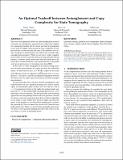| dc.contributor.author | Chen, Sitan | |
| dc.contributor.author | Li, Jerry | |
| dc.contributor.author | Liu, Allen | |
| dc.date.accessioned | 2024-07-10T19:32:52Z | |
| dc.date.available | 2024-07-10T19:32:52Z | |
| dc.date.issued | 2024-06-10 | |
| dc.identifier.isbn | 979-8-4007-0383-6 | |
| dc.identifier.uri | https://hdl.handle.net/1721.1/155584 | |
| dc.description | STOC ’24, June 24–28, 2024, Vancouver, BC, Canada | en_US |
| dc.description.abstract | There has been significant interest in understanding how practical constraints on contemporary quantum devices impact the complexity of quantum learning. For the classic question of tomography, recent work tightly characterized the copy complexity for any protocol that can only measure one copy of the unknown state at a time, showing it is polynomially worse than if one can make fully-entangled measurements. While we now have a fairly complete picture of the rates for such tasks in the near-term and fault-tolerant regimes, it remains poorly understood what the landscape in between these extremes looks like, and in particular how to gracefully scale up our protocols as we transition away from NISQ. In this work, we study tomography in the natural setting where one can make measurements of t copies at a time. For sufficiently small є, we show that for any t ≤ d2, Θ(d3/√tє2) copies are necessary and sufficient to learn an unknown d-dimensional state ρ to trace distance є. This gives a smooth and optimal interpolation between the known rates for single-copy measurements and fully-entangled measurements. To our knowledge, this is the first smooth entanglement-copy tradeoff known for any quantum learning task, and for tomography, no intermediate point on this curve was known, even at t = 2. An important obstacle is that unlike the optimal single-copy protocol, the optimal fully-entangled protocol is inherently a biased estimator. This bias precludes naive batching approaches for interpolating between the two protocols. Instead, we devise a novel two-stage procedure that uses Keyl’s algorithm to refine a crude estimate for ρ based on single-copy measurements. A key insight is to use Schur-Weyl sampling not to estimate the spectrum of ρ, but to estimate the deviation of ρ from the maximally mixed state. When ρ is far from the maximally mixed state, we devise a novel quantum splitting procedure that reduces to the case where ρ is close to maximally mixed. | en_US |
| dc.publisher | ACM | en_US |
| dc.relation.isversionof | 10.1145/3618260.3649704 | en_US |
| dc.rights | Creative Commons Attribution | en_US |
| dc.rights.uri | https://creativecommons.org/licenses/by/4.0/ | en_US |
| dc.source | Association for Computing Machinery | en_US |
| dc.title | An Optimal Tradeoff between Entanglement and Copy Complexity for State Tomography | en_US |
| dc.type | Article | en_US |
| dc.identifier.citation | Chen, Sitan, Li, Jerry and Liu, Allen. 2024. "An Optimal Tradeoff between Entanglement and Copy Complexity for State Tomography." | |
| dc.contributor.department | Massachusetts Institute of Technology. Department of Electrical Engineering and Computer Science | |
| dc.identifier.mitlicense | PUBLISHER_CC | |
| dc.eprint.version | Final published version | en_US |
| dc.type.uri | http://purl.org/eprint/type/ConferencePaper | en_US |
| eprint.status | http://purl.org/eprint/status/NonPeerReviewed | en_US |
| dc.date.updated | 2024-07-01T07:50:00Z | |
| dc.language.rfc3066 | en | |
| dc.rights.holder | The author(s) | |
| dspace.date.submission | 2024-07-01T07:50:01Z | |
| mit.license | PUBLISHER_CC | |
| mit.metadata.status | Authority Work and Publication Information Needed | en_US |
